
Hakea is a genus of about 150 species of plants in the Family Proteaceae, endemic to Australia. They are shrubs or small trees with leaves that are sometimes flat, otherwise circular in cross section in which case they are sometimes divided. The flowers are usually arranged in groups in leaf axils and resemble those of other genera, especially Grevillea. Hakeas have woody fruit which distinguishes them from grevilleas which have non-woody fruit which release the seeds as they mature. Hakeas are found in every state of Australia with the highest species diversity being found in the south west of Western Australia.

Datura metel is a shrub-like annual or short-lived, shrubby perennial, commonly known in Europe as Indian thornapple, Hindu Datura, or metel and in the United States as devil's trumpet or angel's trumpet. Datura metel is naturalised in all the warmer countries of the world. It is found notably in India, where it is known by the ancient, Sanskrit-derived, Hindi name dhatūra (धतूरा), from which the genus name Datura is derived.

Hakea salicifolia commonly known as the willow-leaved hakea, is species of flowering plant that is endemic to eastern Australia. It is an adaptable, fast growing small tree or shrub with attractive foliage and cream white flowers.

Hakea petiolaris, commonly known as the sea-urchin hakea, is a shrub or small tree with cream-coloured and pink or purple flowers and woody fruit. It is endemic to the south west of Australia, occurring at the coastal plain, jarrah forest and wheatbelt regions, often at the ancient granite outcrops of Western Australia.

Chrysocephalum, known by the common name everlastings for their long life as cut flowers, is a genus of flowering plants in the family Asteraceae. There are nine species, all of which were formerly classified under other genera.

Anthocercis viscosa, also known as sticky tailflower, is a species of shrub in the family Solanaceae, native to the south coast of Western Australia. It grows up to 3 metres in height and produces white or cream flowers between May and February in its native range.
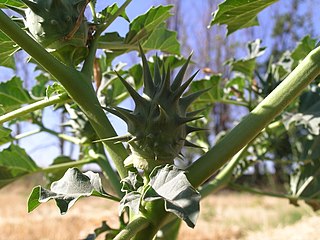
Datura ferox, commonly known as long spined thorn apple and fierce thornapple, as well as Angel's-trumpets, is a species of Datura. Like all such species, every part of the plant contains deadly toxins that can kill animals that ingest it. Its fruit, red-brown when ripe, has unusually long thorns or spikes.
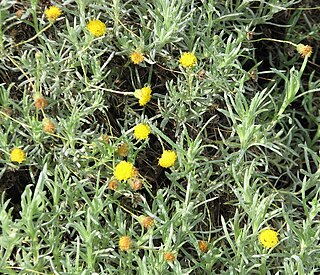
Leiocarpa is a genus of plants in the family Asteraceae, native to Australia.
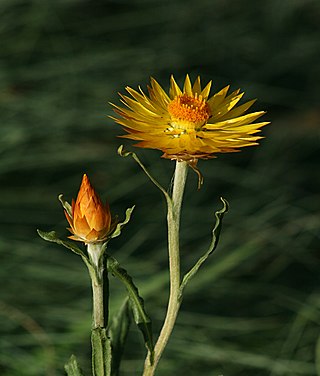
Xerochrysum subundulatum is a flowering plant in the family Asteraceae, native to Australia, growing in Victoria, New South Wales and Tasmania.
Leptorhynchos is a genus of annual or perennial herbs in the family Asteraceae. All species are endemic to Australia. These include:
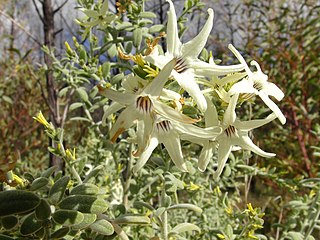
Cyphanthera is a genus of shrubs in the family Solanaceae.
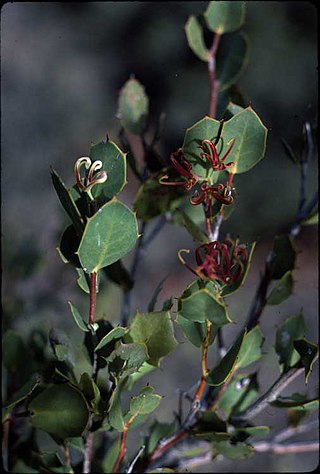
Hakea denticulata, commonly known as stinking Roger is a shrub tree endemic southern Western Australia. One of the many species of Australian plant described by the botanist Robert Brown. A compact shrub 1–2 m (3–7 ft) high and wide with red flowers in the spring with an unpleasant odour.
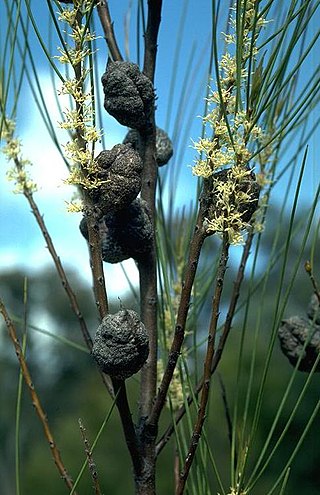
Hakea dohertyi, commonly known as the Kowmung hakea, is a shrub endemic to a restricted locale in the Great Dividing Range in central New South Wales in Australia.

The Solanaceae, or the nightshades, are a family of flowering plants that ranges from annual and perennial herbs to vines, lianas, epiphytes, shrubs, and trees, and includes a number of agricultural crops, medicinal plants, spices, weeds, and ornamentals. Many members of the family contain potent alkaloids, and some are highly toxic, but many—including tomatoes, potatoes, eggplant, bell and chili peppers—are used as food. The family belongs to the order Solanales, in the asterid group and class Magnoliopsida (dicotyledons). The Solanaceae consists of about 98 genera and some 2,700 species, with a great diversity of habitats, morphology and ecology.
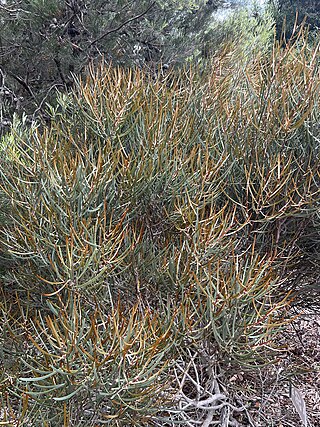
Hakea aenigma, commonly known as the enigma hakea, is a critically endangered shrub in the family Proteaceae endemic to Kangaroo Island in South Australia. It is one of two Hakea species totally reliant on suckering to reproduce therefore having "reached evolutionary dead-ends" as this method of reproduction greatly limits genetic variation. The entire population of this species may be of clonal colonies descended from a single individual.

Hakea eneabba is a shrub in the family, Proteaceae and endemic to an area along the west coast in the Mid West region of Western Australia.
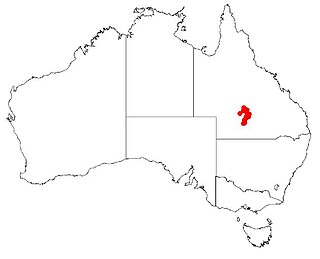
Hakea maconochieana is a shrub in the family Proteacea and is endemic to Queensland Australia. It is a rare species with red flowers, needle-like leaves and an upright or spreading shrub.

Lycium australe, the Australian boxthorn, is a native Australian plant with large sharp woody spines, small leaves and very small berries. It is closely related to Lycium ferocissimum, which is listed as an invasive weed in Australia, New Zealand and Cyprus.
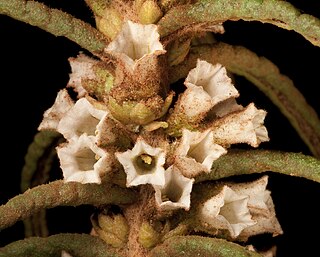
Symonanthus is a genus of flowering plants belonging to the family Solanaceae. The genus was circumscribed by Laurence Arnold Robert Haegi in Telopea vol.2 on page 175 in 1981.
Crenidium is a genus of flowering plants belonging to the family Solanaceae.

















